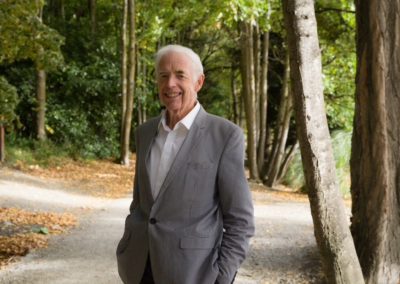Alzheimer’s disease accounts for more than 60% of all dementia cases, and as our population ages it is becoming an even greater societal issue. Huge progress has been made since the identification of Alzheimer’s disease in 1907, however drug trials continue to fail. Professor Jürgen Götz, from the University of Queensland, believes that ultrasound may be the future of Alzheimer’s treatment.
“Alzheimer’s disease is characterised by the build-up of two proteins, amyloid-beta and tau.” Both amyloid-beta and tau are normally present in the brain, but in those with Alzheimer’s disease they start to form sticky lesions that get in the way of normal neural processes. Tau tangles form inside the cell bodies, while amyloid-beta plaques form between cells. This means that not only are the cells struggling to send information through the tau tangles, but when they do manage to get the information out they’re blocked again by the amyloid plaques. Jürgen’s research has shown that ultrasound could be much more effective than drugs along to clear a way through this mess of protein.
We tend to think of ultrasound as visual, a tool we use to see inside of our bodies. In reality, ultrasound is just any sound that is too high pitched for us to hear. When we use it to visualise our organs a computer is using that ultrasonic frequency like echo-location, sending out waves of sound energy and recording what is bounced back. If you’ve ever listened to a deep bass sound on loud speakers, you’ll be familiar with how sound can exert a physical force; these ultrasound frequencies can have a similar effect, just on a microscopic scale.
“First we inject the patient with a contrast agent, so called ‘microbubbles’,” Jürgen says, “and then we expose the targeted brain areas to ultrasound.” These microbubbles are the same contrast agents that would be used in other ultrasound examinations, like echocardiograms, to boost the signal. In Jürgen’s research, however, microbubbles aren’t used to boost the signal, they’re used to disrupt the blood-brain barrier.
The blood-brain barrier is a collection of tightly linked cells that separate our blood supply from our brain, and while it is important for our health it is also one of the biggest hurdles when it comes to treating brain diseases; it can be very difficult to get treatments through the barrier. When the microbubbles are exposed to ultrasound their sizes begin to change, becoming larger and smaller, and disrupting the junctions between the cells of the blood-brain barrier. This technique opens up the blood-brain barrier for a short time and only in the targeted areas.
What happens next is still somewhat of a mystery. “There is some factor (or a combination) in our blood that then triggers the microglia,” Jürgen says, “and they start to attack the amyloid plaques.” What exactly that factor is? No one is certain. What is certain is that the brain’s immune system, the microglia, finally gets with the program and fights back against these toxic amyloid plaques. “We see around a 60% reduction in amyloid plaques, but that is sufficient to then see a massive improvement in our behavioural measures of memory function.”
Tau is a little more difficult to target. Sitting inside the cell gives a tau tangle an extra layer of protection, so the microglia can’t sense them as easily. So, what Jürgen and his team decided to do was to introduce tau antibody fragments. An antibody is what your body uses to identify invading viruses or bacteria; it’s the signal that tells your immune system what to look for and destroy. Antibodies are incredibly expensive to produce and, under normal conditions, the dosage would have to be huge in order to get enough of the antibody into the brain; in normal circumstances it just isn’t a feasible option. Using his ultrasound technique, however, Jürgen and his team were able to get enough of the tau antibody fragments into the brain to see an effect. Microglia began targeting tau, demonstrating that the technique is effective for clearing both tau tangles and amyloid plaques.
Before they can move on to human trials, Jürgen and his team first have to ensure the safety of the treatment. “We’ve chosen to use the sheep as a model, because their brains are closer in size to a human and their skulls are much more similar in thickness.” The larger a brain, and the thicker and more cancellous the skull, the more complex the procedure. Every nanometre of material between the machine and its target can distort the sound wave, setting it off course or allowing heat to build up. If we want this treatment to be safe for humans we need to make sure that it can still work with human-like challenges in its way.
Progress can seem slow for diseases like Alzheimer’s. It feels as though every year we’re hearing about potential new drug treatments, and then having that hope squashed by clinical trials. It’s important to remember that research on the scale we see now has been around for fewer than 50 years. There were just six years between Einstein declaring the atom indestructible, and the splitting of an atom; no one can truly predict what is impossible. In the case of Alzheimer’s disease, maybe what we’ve been waiting for is Jürgen’s technological leap toward ultrasound.



